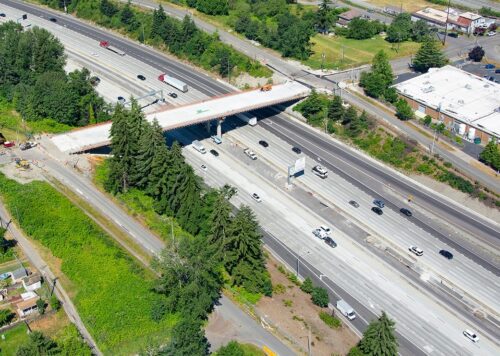South Tacoma Green zone SML proposal plan
Neighborhood group proposed changing the area into a Green Zone. After a series of hearings on developing a mega-warehouse district in South Tacoma, the city favored commercial development over neighbors’ health and environmental concerns. What have we learned about this process?
Earth Justice appeals expansion of South Tacoma Warehouse District
by Kirk Kirkland
Like other large cities from Everett to Olympia, the City of Tacoma has ignored the health of its underserved populations that live in proximity of Interstate Five.
These underserved neighborhoods are identified by U.S. Environmental Protection Administration (EPA) mapping that identifies high numbers of low-income people and people of color. The county health department measures show that in these neighborhoods, people often die earlier and are more affected by the air pollution generated by diesel trucking and other pollution near Interstate 5.
Two recent commercial developments in Tacoma were proposed, raising concerns about environmental justice. Bridge Industrial of Bellevue has proposed a massive warehouse district in South Tacoma. “This proposal is not only harmful to the environment, it is also inequitable,” according Molly Tack-Hooper in her April 21, 2022 letter to the city of Tacoma from Earth Justice.
These two permits were handled by the city in a clever way that avoided environmental review that would normally be required by the state Environmental Policy Act. This has become common practice in Pierce County and other cities. For advocates and neighborhoods to be successful in stopping or modifying these projects, there needs to be a change in policy so that cities and the county cannot so easily issue Determinations of Nonsignificance. Environmental Impact Statements must be required.
This review of what happened in Tacoma is a case study that should be helpful in changing policy and in informing neighborhoods about the obstacles they face in making successful modifications to large commercial projects.

The appeal of the city’s permit by Earth Justice in May of 2023 called for a full Environmental Impact Statement which would advance environmental justice by assessing impacts on nearby neighborhoods for environmental quality and health outcomes.
The City of Tacoma’s Growth Management Policies
City Policy UF–1.11, calls for “evaluating the impacts of land use decisions and development on the characteristics of neighborhoods and current residents, particularly underserved and under-represented communities.”
It was interesting to read the terms used by planning staff to avoid discussing the effects of zoning in neighborhoods with low socioeconomic status and larger numbers of people of color.
In Tacoma, city planners did not make an evaluation of “underserved” neighborhoods when they granted a permit for Bridge Industrial’s warehouse district in South Tacoma. Moreover, there was no evaluation made for a Growth Management Amendment for the company Mor Furniture Stores.
The city issued a Determination of Nonsignificance, environmental advocates protested the use of the DNS, but city officials refused to study the environmental consequences of the project.
Mor Furniture Store Amendment: Tacoma’s Growth management Policy for “underserved” neighborhoods was not evaluated before this Growth Management Amendment was heard by the city’s Planning Commission.
Other policies were also ignored including Policy DD–11.4, Policy DD–12.1, Policy DD–12.2, and Policy DD–12.3 which pertains to “encouraging development, infrastructure, and building design that reduces negative impacts on environmental health, ecosystems, and sensitive areas, and on community health and safety.”
Mapping provided by EPA Environmental Justice showed that residents in this zip code near the Mor Furniture Store are: people of color (55%), low income people (81%), people over 64 years old (20%), and people with a higher unemployment rate (21%).
In the report on Environmental Justice in 2021, the Front and Centered Coalition stated “Decisions by land use agencies have been a major contributor to this inequality. A central theme identified in community conversations about environmental justice in Washington is that unjust land use policies have caused people in disadvantaged communities to live in close proximity to pollution.”
The Mor Furniture Amendment would rezone its property next to Interstate 5 in a neighborhood disproportionately exposed to environmental harms and health disparities, according to the Tacoma- Pierce County Health Department.
Initially, the proposed Mor Outlet Store did not receive a traffic study. It is located on a dead-end road used by school buses for an adjacent school. City planners refused the request from environmental groups and others to provide a complete environmental analysis which is required by the state Environmental Policy Act.
It is a common practice for many cities and the county to determine that commercial developments like these have “no significant impacts”. After a Determination of Nonsignificance is issued, a court appeal as the only way to address health and environmental concerns about these projects.
In the case of the Bridge Industrial proposal, Earth Justice appealed the permit but was not successful. This is by design, as the hearing examiner rarely agrees with environmental protests. The issue must then be settled in higher courts.
City councilmembers were sympathetic to South End Neighborhood Councilmembers who proposed creating a “Green Zone” in the area, which is also a superfund site that sits above a major aquifer used for drinking water.
The city council recommended a moratorium to the planning director until the conflict with the proposed Green Zone and the warehouse project could be resolved. Eventually, the planning director approved the warehouse proposal.

In the case of the Mor Furniture Store, the GMA Amendment was approved by Tacoma’s Planning Commission and the City Council.
After a little networking among neighborhood leaders and some canvassing, advocates appeared before the Tacoma Planning Commission and testified along with 13 people from the city and neighborhood.
Tahoma Audubon sent a letter to the commissioners and the city planners, pointing out city policies concerning “underserved” neighborhoods. Two weeks later, the combination of getting good information out to the neighborhood and to the commission worked.
At the May 17 meeting of the Tacoma Planning Commission, the staff recommended that the amendment be denied. They concluded that “this community is already overburdened, especially as it pertains to adverse air quality, and higher incidents of disease commonly related to air pollution, and that the area’s proximity to Interstate 5 increases air pollution exposures.”
Initially, it seemed that the public hearing process was successful and a costly court appeal was avoided. Unfortunately, the City Council disagreed with the Planning Commission and passed the rezone of the property.
This is not a neighborhood that can afford a costly appeal. In the case of the South Tacoma Warehouse District, the planning director chose to ignore public hearings from the “overburdened” neighborhoods about pollution, the impacts on the underlying aquifer, and the problems of building on a Superfund site.
Both of these zoning cases reveal the difficulty of using the Growth Management Act and the city’s zoning plan to protect neighborhoods from environmental injustice.
There is a bias in the city administration that favors jobs and commercial development. The state Environmental Policy Act and the Growth Management Hearings Board could overrule the city’s decision, but funding of an appeal is likely out of reach for the affected neighborhoods.
To make the process more accessible for neighborhood and environmental advocates, a change in policy by the city and the county could reduce the frequent use of Determinations of Nonsignificance.
In both cases, a traffic study and more information from the Health Department about public health concerns would have helped. With the Superfund site as a consideration, more information was needed about surface water from roofs and parking lots no longer recharging the aquifer.
Both the city and the county now have adopted the pattern of only conducting Environmental Impact Statements when forced to. Sadly, for activists to take on a case like this, it is necessary to commit to the expense of appeals to make the laws of the state work.
The policies of the planning department in the city and the county can be changed by electing people to these councils who would change the planning department’s policies.
Four county councilmembers seats are up for election in 2025. What is needed is for environmental advocates to raise their concerns and determine which councilmembers and candidates are willing to address this issue of environmental injustice.
On the years that have elections, ours is a government by the people. Environmental justice for our community can be achieved over time by electing people who are mindful and willing to take action.


